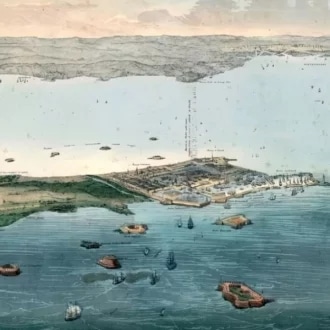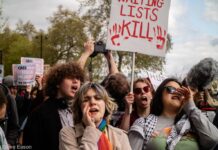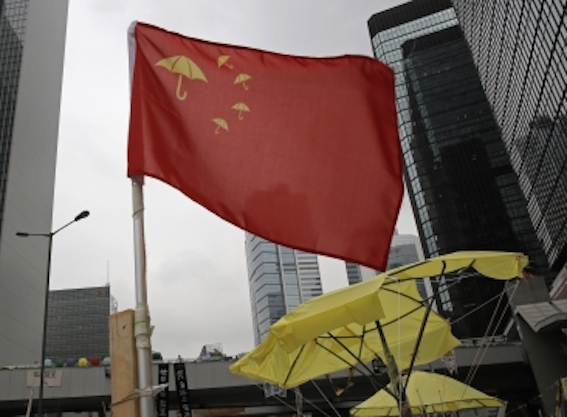Marcus Hesse, Socialist Alternative (ISA Germany)
The events in Kronstadt in March 1921 are exploited by critics of Bolshevism — whether anarchists or from the pro-capitalist right — in an attempt to demonstrate that not only under Stalin, but already under Lenin’s and Trotsky’s leadership a brutal dictatorship ruled over the workers in the new Soviet Russia.
An uprising by sailors and others in Kronstadt, a fortress island off Saint Petersburg (then called Petrograd) in March 1921 was put down by the Bolsheviks in what Leon Trotsky called a “tragic necessity”. Many opponents of the Bolsheviks expected that when the Soviet archives were opened, there would be a flood of information to confirm their claims of Bolshevik violence, but the opposite happened. A true milestone in research on the subject is the two-volume collection of sources “The Kronstadt Tragedy,” published in Russia in 1999, which contains numerous previously undiscovered documents.
They contradict the claims of “left-wing” critics of the Bolsheviks, that they represented, under Lenin and Trotsky, the degeneration of the revolution, and that the rebels allegedly represented “authentic Soviet democracy”.
The roots of the crisis
The October Revolution in Russia was carried out with the assumption that other countries would follow. Yet Soviet power remained isolated, while one-million strong Tsarist and Whiteguard armies, supported by up to 2 million troops from imperialist powers such as Germany, Japan, Poland and Britain launched a brutal civil war. By the winter of 1920/21, the Red Army had won, but the country had been devastated, famine and epidemics raged across the country, cities like Moscow and Petrograd had lost much of their population, and factories were practically not producing.
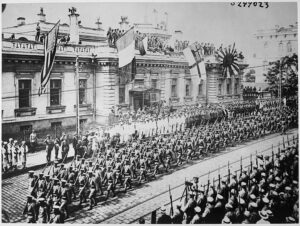
The peasants had received land when the Bolsheviks took power in 1917 and wanted to be able to finally do what they wanted with it. As the White armies wanted to return the land to the landowners, the mass of the peasantry still fought enthusiastically alongside the Bolsheviks and filled the ranks of the Red Army. As about 90% of the Russian population was comprised of peasants and agricultural workers, the communists relied for support primarily from the industrial workers in the cities and the poorest elements of the peasantry, agricultural workers, and village poor.
But as the factories could no longer produce enough industrial goods to support agriculture, and with the cities starving, the Bolsheviks collected grain from the peasants during the civil war in what was known as “war communism”. Although Lenin and Trotsky pushed early on for greater concessions to the mass of small and medium landowners, the state of the civil war, with industry having nothing to offer the peasantry in exchange for their products, did not permit this.
This created tensions. When the counter-revolutionary enemy was defeated, conflicts between the workers’ state and peasant smallholders erupted, which forces such as Mensheviks and Social Revolutionaries (SRs), who had opposed the socialist revolution in 1917, exploited. There had been strikes and peasant uprisings as early as 1918 but by 1921, there were local uprisings of peasants throughout the country. In 1920–21, the right-wing Social Revolutionary Antonov led a “green” peasant army against the Red Army in Tambov province, demanding the reintroduction of a market economy, a return to parliamentarism, and killing communists and their families. Many peasants directed their hatred against “the communists” and especially the “commissars” (communist officials). Since the Bolshevik Party had renamed itself the “Communist Party” in 1918, terms like “Bolsheviks” and “Soviet power” still sounded good to the peasants — they stood for the distribution of land in 1917, while the “communists” and their “commissars” confiscated their grain to feed the cities during the civil war.
In February 1921, this discontent reached the exhausted revolutionary stronghold of Petrograd. Two thirds of the 1917 population had left the city, either to serve in the army or, more often, simply to return to the countryside. The once vibrant democracy of the Soviets was flagging. Workers were tired, exhausted, suffering from epidemics and starvation. The Communist Party had become the dominant, and often only, party in the Soviets and factory committees, as SRs, Mensheviks and many anarchists had taken up arms against Soviet power and were therefore excluded. Due to the needs of the civil war, there were retreats from the democratic gains of the revolution as military decisions often had to be made quickly by party and state representatives. This paralyzed mass initiative from below.
Nevertheless, there was still lively and open discussion within the Communist Party about the role of the trade unions, the change of economic policy, and democratization after the end of the civil war.
The February Crisis of 1921
By the end of 1920 the grain expropriations from the countryside were no longer enough to feed the cities. The terrible decision to cut the bread ration was made in January, which not only created hunger but led to a big increase in dissatisfaction in the workplaces. Careless reactions by the militia and the ‘Cheka’ — the special commission originally established to combat speculation and anti-Jewish pogroms — led to sharp conflicts with workers (including union and party members). A fuel shortage was the straw that broke the camel’s back, leading to the closure of over 60 factories due to the lack of energy. Demonstrations broke out often with demands such as “Our children need bread” and “We’re dying from hunger”, and there were a number of strikes. Often Bolshevik orators were not allowed to speak, while Mensheviks and SR speakers called for an end to grain requisitions and the restoration of the constituent assembly, in effect a demand to return to bourgeois parliamentarianism.
Whipped up by desperation amongst the masses anti-Semitic slogans sporadically emerged. In his work on the Kronstadt Uprising, the anarchist historian Paul Avrich described the panic that gripped Petrograd’s Jewish community at the time. Fearing pogroms, they turned to the Bolshevik Defense Committee of the Petrograd Soviet, led by Zinoviev. The Bolsheviks had factories militarily locked down and leading Mensheviks and agitators from other parties and anarchists were arrested. For the most part, however, negotiations succeeded in preventing further escalation. The crisis ended when the bread allocation was restored, although the supplies needed for this were still forcibly requisitioned.
Supporters of the Kronstadt uprising claim that it coincided with the Petrograd workers’ strikes, but they had already ended when the revolt in Kronstadt broke out.
The naval base revolts
Kronstadt was a stronghold of the revolution in 1917, with many sailors fighting on the front lines of the civil war. Trotsky had called the radical sailors the “pride of the revolution”. He explained how in the early period Kronstadt seemed to provide inexhaustible numbers of sailors to help Moscow, or to requisition bread and organize soviet power, but by 1919
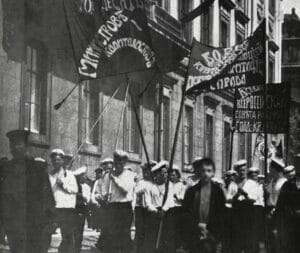
In 2002, historian Israel Getzler, in his book “Kronstadt 1917–21 — The Fate of Soviet Democracy”, tried to prove that most of the 1921 rebels had already been in the Baltic Fleet in 1917. In fact, he did not succeed in doing this. Apart from anything else, well over half of the Kronstadt garrison were too young to have served in 1917. He did explain that many of the Bolshevik sailors and workers at the garrison who had been party members in 1917 had left to serve on the front or in government posts, many of the party members left had joined in 1919 or later, when no longer expected to make such sacrifices. Even then, the number of active communists among the sailors declined towards the end of the civil war often leaving the party out of religious sentiments, or unpaid membership dues. Alienation was particularly great among sailors from peasant families, especially if they came from the more prosperous and grain-rich areas of southern Russia and Ukraine.
Other sailors among the approximately 16,000 marines in Kronstadt, however, remained true to their communist views and loyal to the Soviet government. This led to strong tensions within the garrison: many sailors refused to participate in the uprising and courageously opposed it. The authority still held by many communists within the garrison, as well as the splits within the sailors and other workers in Kronstadt is confirmed by the eye-witness account of no other than Ivan Oreshin, deputy to Petrichenko, leader of the Kronstadt uprising — see box.
Excerpts from the notes of Ivan Oreshin, written in 1924
The protest of the Kronstadters took a peculiar and, it must be said bluntly, cautious form. In the early days of the uprising, the Kronstadters, having seized power in the city, arrested the communists, aware that they represented a great moral force in the eyes of all working Russia. They expected to achieve significant concessions and immediately took a defensive position without weapons, without taking drastic measures.
They were so sure that the St. Petersburg workers would immediately support them. After all, St. Petersburg workers had asked them to help them, to support them! The Kronstadters arose, thinking they would be the spark that would this time bring a complete victory! Peter (Petrograd) will flare up, and from there the whole of Russia. They believed it would be easy as the spring events had shown, almost the whole of Russia was ablaze in an uprising against the Bolsheviks. But the Kronstadters were wrong. Petrograd workers did not respond, the barricades had been taken down… and the Kronstadters were left on their own…
… unrest began on the ships a few days before March 1. On the large battleships (Sevastopol and Petropavlovsk) and in other marine areas, sailors began to discuss the “state of things” in connection with the “riots” among the workers in Petrograd. The sailors were not the same as in 1917–18. The revolutionary fervour had left them, they had lost their reckless enthusiasm with which they had dispersed in January 1918 the Constituent Assembly…
… Guards from the Petropavlovsk could easily have captured the city that day, but they didn’t. On the next morning the School of Cadets and the cheka left the city through the citadel gate and withdrew to the fort “Krasnaya Gorka”. They joined the wavering garrison and formed it into a fighting nucleus, and when hostilities began, established a strong base of operations against Kronstadt, and using systematic artillery fire against the city and its forts having a negative effect on the rebels and causing, of course, quite a lot of material damage”
The sailors of 1917 did not think much of the demand for “freedom for all socialist parties” either — after all, they knew what a negative role the SRs and the Mensheviks had played in the revolution and civil war. For this they were repressed by the rebels or had to leave the island.
At a tumultuous meeting on March 1, at which speakers from the Communist Party (who were initially allowed to join in the discussion) were shouted down, an unelected “Provisional Revolutionary Committee” (PRC) was formed, led by the sailor Stepan Petrichenko. He had been at various times an anarchist, a social-revolution and even, for a short period after 1919 a member of the communist party, recruited as part of the ‘Lenin levy’, before losing his card in the next reregistration. The committee presented itself as deliberately ‘non-partisan’ and propagated ‘soviets without parties’. Well over half of the members however were active Mensheviks, Social Revolutionaries, anarchists and ‘narodniks (right wing socialists), along with a certain General Kozlovsky, who commanded the rebel artillery. He had been a Tsarist general, but had served the Red Army as a ‘military specialist’.
Starting with the demand for new elections to the Soviets, the slogan “Soviets without Communists!”, quickly arose. In different forms, this was continuously declared, including in the “Kronstadt Izvestia” paper of the uprising, as the declared goal of the uprising. The PRC had 300 of the Bolshevik cadres arrested. Supporters of the uprising stress that a resolution demanding the death penalty was rejected, yet this was a close run thing. From the documents in “The Kronstadt Tragedy” it is clear that the mass shooting of the imprisoned communists was only prevented because they feared retribution by the approaching Red Army. Foremost among those publicly demanding their execution was the anarchist and prison chief (this combination existed in Kronstadt!) Stanislav Shustov.
At the March 1 meeting, held on Kronstadt’s central “Anchor Square”,“ Commissar of the Fleet Nikolai Kuzmin and President of the Central Executive Committee Mikhail Kalinin spoke for the government. Apparently, they were not too skilful at de-escalating the situation, telling the sailors that Kronstadt would be isolated, and the Bolshevik government would never let them win. This just incited the rebellion. On March 2, the Soviet government officially called the uprising a ”counterrevolutionary White Guard conspiracy.”
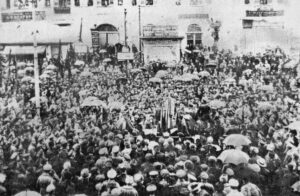
Perhaps a more skilful and honest approach by the representatives of the Soviet power could have eased the situation and prevented thousands of sailors and some civilians from joining an armed anti-communist uprising. Although another eye-witness account says that this was not the main factor. The crowd was whipped up by orators who falsely claimed that there were already hundreds of Red Army troops approaching the fortress ready to destroy it.
Following this, members of the Communist Party in Kronstadt were put under massive pressure by the rebels to publicly declare their resignation from the “Party of the Executioners of Russia”, as reports of contemporary witnesses show. Resignations were printed in the insurgents’ newspaper. On March 3, the “Provisional Revolutionary Committee” around Petrichenko imposed a state of emergency and a curfew for the entire fortress city with its 26,000 inhabitants, who thus became hostages of the rebels.
The program of the rebels
On March 1, the famous 15-point resolution was adopted at the meeting of 16,000 sailors that is generally considered to be the beginning of the open revolt. Many supporters of the uprising see it as proof that the sailors stood for socialist goals and workers’ democracy. On the surface, many of the demands were based on calls for a restoration of Soviet democracy, which had been dramatically reduced during the civil war. The resolution demanded the re-election of the Soviets and freedom of the press for all socialist parties, including for the right Social Revolutionaries and Mensheviks, who had not only been in power before the October revolution and complicit in the persecution of the Bolsheviks then heavily involved in the civil war in alliance with the counter-revolutionary White armies.
The anarchist historian Paul Avrich explains that the demand “Soviets without communists” was not one of the official demands included in the fifteen points, but as he says it quickly became the essence of all the other demands of the rebellion. This was not new, it was a demand raised continuously by those parties opposed to the Bolsheviks and who had been involved in organising the peasant uprisings.
There was a demand for equal food rations for all. During the civil war, there were extreme shortages of food for all. Even though there was still the forced requisitioning of grain and other products from the peasants, there was still rationing. By the end of the civil war there were at least 33 different levels of ration — amongst the largest rations were those for workers in dangerous jobs, red army soldiers, pregnant women, teenage children, medical workers particularly those working in pandemics. In Moscow too, Lenin signed a decree in 1920 giving key ‘especially important specialists’ higher rations, to ensure they could complete their daily work, sometimes exceeding 16 hours a day. This was a break with socialist principles, but was an economic necessity to use their expertise and skills. Among party members in leadership positions, there was a wage maximum at that time.
The insurgent sailors were generally well-fed, with significantly higher rations than the workers of Petrograd. In fact, discontent on the two ships “Petropavlovsk” and “Sevastapol” had developed a couple of months not particularly because of poor rations, but because the two ships had been moved from Petrograd to Kronstadt.
But a more important demand of the insurgents was the demand for free trade in grain, a demand that clearly corresponded to the interests of the middle and richer peasantry, and would hardly have benefited the working and starving masses at that time.
It was a contradictory program in every respect. In any case, the claim by anarcho-syndicalists, or by the Dutch ‘council-communist’ Cajo Brendel that the uprising was the last revolt of the proletariat against Bolshevik “state capitalism” is politically absurd. The rebels’ tone grew more aggressive by the day, fuelled by scattered rumours of repression in Petrograd. Openly counter revolutionary organizations put out feelers to the rebels.
The strongly emphasised attacks on the Communist Party and the demand for free trade explosively revealed the peasant character of the uprising. “Kronstadt Izvestia” claimed that “the rule of the communist commissars” was worse than that of the tsar. That many of the rebels were not particularly left-wing was demonstrated by the fact that the editors could only with great effort prevent the printing of anti-Semitic appeals. In “The Kronstadt Tragedy”, a letter written by the sailor Dmitri Yurin on March 4, which fell into the hands of the Red Army, is cited as an example of this mood among the rebels. There it says: “We have chased the commune apart, there is no more commune, now we have only Soviet power. We have passed a resolution in Kronstadt to banish all the kikes to Palestine, so that there won’t be such an abomination in our country. All the sailors are shouting ”Down with the kikes!“, we’ve been fed up with them for the last few years, and we’ve been fed up with the commune for four years too!”
Political ideology of the rebels
The political ideology of the rebels was characterized by a crude mixture of anarchism, petty-bourgeois prejudice, peasant populism and nationalism. Articles and even poems published in “Kronstadt Izvestia” speak for themselves.
March 9: “The rule of the communists has brought unprecedented misery, hunger, cold and many other misfortunes to the whole of Russia. […] The Communists do not need you, but power over you, so that they can continue to exploit the people for their own good […] In order to destroy family life, our rulers have introduced communal canteens!”
March 11: “A new communist servitude has emerged: the peasant has become a servant on a state farm, the worker a wage earner in a state factory.” It was sung: “Rise up, peasant people! / A new dawn is breaking / We will shake off the chains of Trotsky / And the tsar Lenin”
The anarchist historian Paul Avrich, while sympathetic to the rebels as a whole, analyzed their nationalism, ignorance of, and disinterest in real world revolutionary events, despite occasional abstract appeals to the “international proletariat” and “world revolution”.
Communism was described as “foreign to the country.” In the early days, it was noticeable that Trotsky and Zinoviev, who because of the Jewish background were treated as special enemies, and attacked by name. Lenin and Kalinin were initially looked on more favourably, because they were “real Russians.” Only when they called the rebels “White Guard conspirators” did the hatred of the rebels turn against them personally.
“Real soviets”, without parties and especially without communists, were seen by the rebels as “organs of the people” — the communists and commissars were declared to be the troublesome enemy. In this way, the Kronstadters were clearly tying in with reactionary ideas. However, most of the Kronstadt rebels also rejected parliamentarism and the constituent assembly demanded by the Mensheviks and the SRs. Lenin was mistaken when he called the March 1921 uprising a “revolt for the Constituent Assembly.”
Anyone who takes a closer look at the crude ideas of the leaders of the uprising will quickly realize that this rebellion as a whole had no progressive orientation and certainly did not stand for a better form of socialism!
Now these people had the important naval fortress in their hands, with heavy artillery and numerous warships still lying in the icy bay.
The Red Army strikes back
The rebels wanted to buy time until the ice of the bay melted, and their warships had free passage to Petrograd. Attempts at mediation, including by the anarchist Emma Goldman and her comrade Alexander Berkman, failed. Finally, on March 5, Trotsky, on behalf of the Politburo, gave the rebels an ultimatum to surrender. The response had to be quick. Starting on March 7, 17,000 Red Army soldiers stormed the fortress with artillery fire across the icy bay. It took several waves of attack, as the insurgents could easily mow down the unprotected troops rushing forward. In the end, planes were used, first dropping leaflets and later bombs.
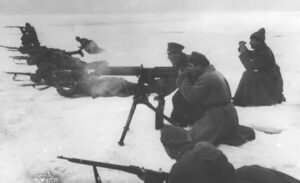
In anti-Bolshevik literature, it is often claimed that there were mass desertions from the attacking Red Army troops. In fact, this happened sporadically — but rarely for political reasons, rather than out of understandable fear for their own lives during this dangerous operation.
When such desertions were politically motivated, they were rarely for progressive reasons. Sometimes soldiers of peasant origin refused to fight for “the Jews” and were replaced by reliable Red officer students (Kursantiy) from the Communist Youth League. Among the rebels, some agitators also tried to persuade Red Army soldiers defect with anti-Semitic slogans. Fortunately, they rarely succeeded.
The fact that in Kronstadt itself by no means all sailors, let alone civilians, were behind the uprising was demonstrated by the surrender of one of the garrison’s as soon as the Red Army entered the city. According to Paul Avrich, some sailors actively sided with the Red Army and took up arms against the rebels.
On March 18, after bloody house-to-house fighting, the uprising was defeated with tremendous losses. The defense of Soviet power cost the lives of about 10,000 loyal Red Army soldiers. 300 delegates of the tenth Party Congress of the Communist Party, which had been taking place at the time had voluntarily joined them at great sacrifice. Among them were members of the “Workers’ Opposition” and the “Democratic Centralist” factions, who were strongly critical of the Soviet government but recognized the counterrevolutionary character of the Kronstadt Uprising. They were opposed in principle to concessions to private trade and the peasantry.
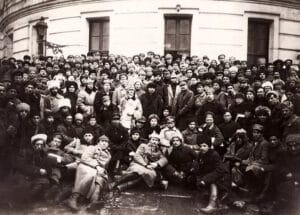
The fact that delegates to the ruling party’s congress risked their lives in struggle clearly shows that the party was not yet completely bureaucratized at that time and could rely on the sacrifice of members even in leading positions. Delegates fought with weapons in their hands and served as agitators. A good sixth of the party conference delegates who went into battle died on the ice of Kronstadt Bay.
The political consequences
The rebels suffered far fewer victims. Petrichenko, leader of the uprising, and several thousand rebels, including a large part of the rebellion’s leadership, fled across the ice to White-ruled Finland shortly before the Red Army troops entered Kronstadt, where they maintained contacts with counterrevolutionary right-wing groups in exile. Of those who didn’t flee, several hundred were sentenced to death, although most were then amnestied. Others were imprisoned in camps intended for prisoners of war — some later ended up in the Solovetsky prison, which opened in June 1923 and later became part of the notorious ‘GULAG’. Several years later they were released under a general amnesty.
Petrichenko continued his exceedingly strange career. He was a notorious adventurer, and at least one whiteguard group claimed he was working with them during the uprising. Whilst in exile in Finland, he shifted towards Stalinism, later returning to the Soviet Union where he cooperated with the Stalinist secret service GPU. Later Stalin imprisoned and executed him.
Lenin thought of disbanding the Baltic Fleet altogether shortly after the Kronstadt Uprising, but the proposal of this alleged “dictator” and “new tsar” was simply democratically outvoted in the party. Eventually Kronstadt again became an important naval base, helping to secure Petrograd and later Leningrad during the war. The rebel ships “Petropavlovsk” and “Sevastopol” were renamed the “Marat” and “Paris Commune” to honour the revolutions of the past.
As early as Spring 1920 Trotsky had first raised the need to replace grain requisition with a progressive income tax, but his proposal was then defeated within the party. But in the summer of 1921, the New Economic Policy was adopted. This largely met the economic demands of the Kronstadt sailors by replacing grain requisitions with a natural tax and making small private trade possible again. This benefited the peasants, craftsmen and small traders, but over time strengthened the bureaucratisation of the Soviet system and even raising the danger of capitalist restoration.
Politically, however, the uprising tore deep wounds.
The tenth Party Congress, during which the uprising had started, was able to continue after the defeat of the uprising. To consolidate the unity of the party in the crisis, a ban on inner-party factions was adopted. Instead of more democracy, there was less. However, it should not be forgotten that until the mid-1920s SRs, Mensheviks and anarchists were still able to run in Soviet elections and elections for factory committees. Only after the crushing of the Left Opposition could the new bureaucracy put an end to this as well. The last legal anarchist clubs and associations were simultaneously banned and closed.
Conclusion
Kronstadt 1921 was not the first, but the most dramatic and symbolic culmination of a conflict between demoralized workers and peasants and Soviet power under conditions of isolated revolution, hunger and exhaustion.
The uprising opposed a revolution that was struggling to survive in a difficult situation. If these forces had been allowed to continue, the achievements of 1917 would have come to an end. Reactionary forces of all kinds could easily hide behind the slogan “Soviets without Communists”. In 1921, the reactionary forces themselves made no secret of their desire to achieve their goals, if necessary, through the detour of soviets without Bolsheviks.
Leader of the liberal bourgeois Cadet Party, Miliukov, was cited by Lenin and Trotsky as an example. Trotsky pointed out in 1921 how euphorically the capitalists abroad, and especially the stock exchange, had reacted to the uprising.
Especially by anarchists, Kronstadt 1921 was and is always used as a showcase example to dissociate themselves from Bolshevism. To this day, anarchists cite the old accounts of the uprising by Emma Goldman, Alexander Berkman, Voline in which the reactionary sides of this revolt are largely ignored or downplayed. The work of Paul Avrich is an exception.
In broad terms, the anarchist view is based on the idea that anything that comes “from below,” opposes central political power, and is apparently spontaneous, and on those merits alone stands for a better and more correct socialism.
In 1921, many anarchists were on the verge of joining the Communist International. This was especially true of the influential syndicalist CNT in Spain. “Kronstadt” was seen as a reason for them not to take this step by a majority.
Anarchists like Emma Goldman in particular denounced Trotsky as head of the Red Army for suppressing the Kronstadt uprising. They also denied him any solidarity as Stalin increased repression in the 1930s. “Trotsky protests too much,” Emma Goldman wrote in the wake of the bloody persecutions of communists in the “Moscow Trials”!
When Trotsky paid tribute in a speech to the Red Army soldiers who lost their lives in the storming of Kronstadt, he chose the following words, pathetic but appropriate in view of the tragic event and the death of 10,000 fallen fighters in defense of the revolution:
“We waited as long as possible so that our deluded fellow sailors could see with their own eyes where the revolt was leading them. But we were confronted with the danger that the ice would melt and we were forced to strike quickly, fiercely and decisively. With unparalleled heroism, in a show of arms unprecedented in military history, our kursanti (military cadets) — and the Red Army units they inspired — took a formidable sea fortress by storm. Without firing a single shot, these sons of Russia and of workers and peasants, made themselves worthy of the revolution through their sacrifice, and advanced across the ice. Some of them perished without a word of complaint, but the rest continued the advance until ultimate victory. They will never be forgotten by the working masses of Russia and the whole world.”
The main driving force behind the uprising was the disenchantment of the rank and file sailors, a reflection of the mood amongst the peasantry in 1921. Lenin, Trotsky and the Bolshevik Party recognized this. With the NEP, they radically changed their course toward the peasantry with the understanding that a breathing space was needed whilst revolutionary events developed in other countries. Lenin described the Kronstadt Uprising as a “lightning bolt” that “illuminated reality”.
It remains important today to draw lessons for the future. Revolutionaries should not simply celebrate the events of Kronstadt as a heroic deed of the Bolshevik units, but understand the perspective of those historically responsible. The suppression of the uprising was, as Trotsky wrote, a “tragic necessity”, they faced no alternative if Soviet Russia was to survive.

